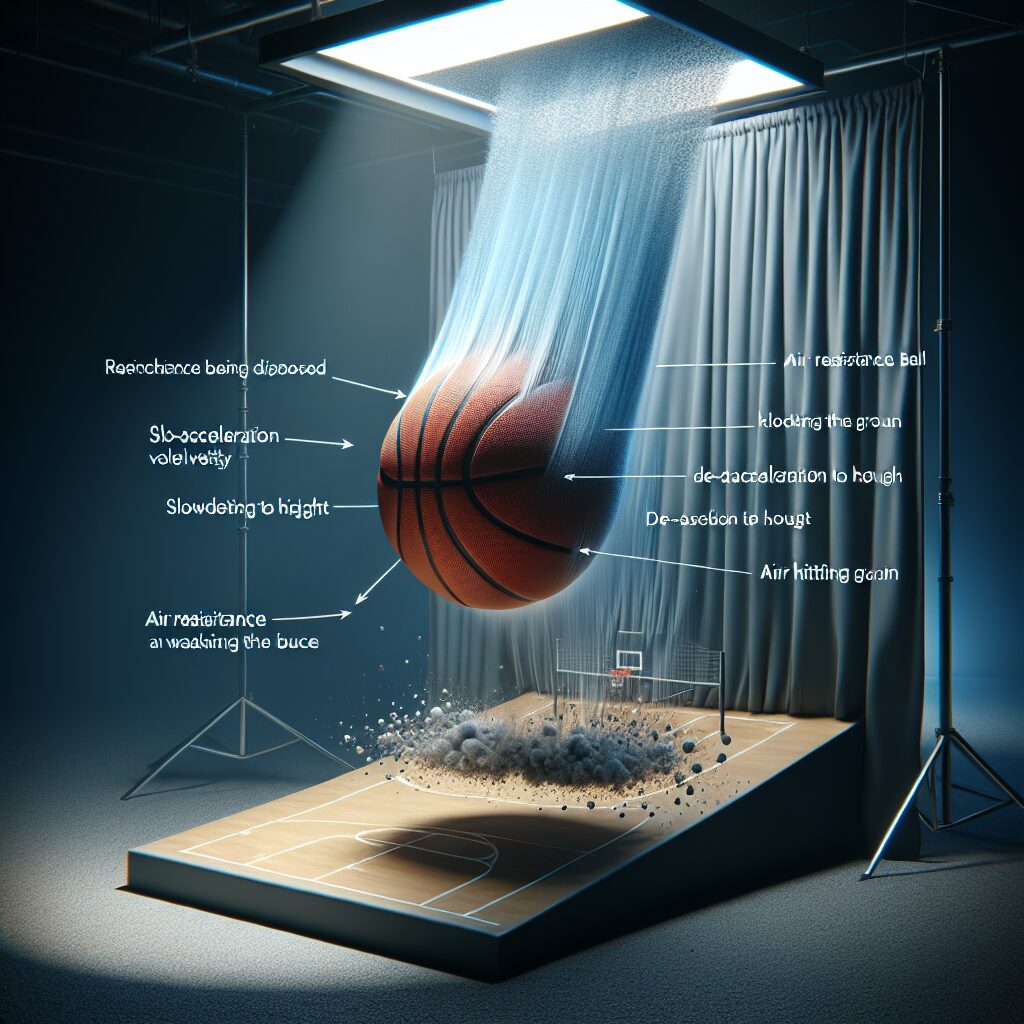Air resistance is a branch of fluid dynamics that plays a significant role in various phenomena, particularly in the world of sports. When it comes to ball bounce, air resistance has a substantial impact on the dynamics and behavior of the ball during its flight and upon impact with the ground or any other surface. This resistance occurs due to the frictional forces exerted on the moving object by the air molecules it encounters. Unlike other types of resistance, such as friction between solid surfaces, air resistance depends on various factors like the shape and size of the object, its velocity, and the characteristics of the air through which it moves.
Understanding the impact of air resistance on ball bounce can provide valuable insights for athletes, ball manufacturers, and sports engineers alike. The presence of air resistance affects the trajectory and speed of the ball, altering its bounce characteristics in different sports like tennis, basketball, or soccer. Furthermore, the properties of the ball, including its shape, size, and surface roughness, interact with air resistance and influence how the ball travels and behaves during play. By delving into the complex relationship between air resistance and ball bounce, we can gain a better understanding of the underlying physics that governs these interactions, paving the way for improved sporting equipment and enhanced performance.
In the upcoming sections, we will explore the key takeaways related to air resistance and its impact on ball bounce. We will discuss how air resistance affects the trajectory and speed of the ball, how it influences the spin and control of the ball, and how different ball characteristics can be optimized to minimize the effects of air resistance for optimal performance on the field. By the end, readers will have a comprehensive understanding of the intricate relationship between air resistance and ball bounce, enabling them to appreciate the science behind their favorite sports and the crucial role of physics in shaping athletic outcomes.
Key Takeaways
1. Air resistance significantly affects the bounce of a ball, causing it to lose energy and height with each bounce.
2. The drag force caused by air resistance depends on the size, shape, and velocity of the ball, as well as the density and viscosity of the air.
3. The coefficient of restitution (COR) measures the efficiency of energy transfer during a ball’s bounce, with lower values indicating greater energy loss due to air resistance.
4. Different types of balls, such as tennis balls and basketballs, experience varying levels of air resistance due to their different sizes, shapes, and materials.
5. Understanding the impact of air resistance on ball bounce is crucial for industries such as sports equipment manufacturing, where optimizing performance and efficiency is essential.
How Does Air Resistance Affect the Bounce of a Ball? Exploring the Impact
1. Understanding Air Resistance
Air resistance, also known as drag, is the force exerted by the air molecules on an object as it moves through the air. It opposes the motion of the object, causing a resistance that alters its trajectory and behavior.
2. The Relationship Between Air Resistance and Ball Bounce
Air resistance plays a crucial role in determining the bounce of a ball. When a ball is dropped or thrown, it experiences both gravity and air resistance. The interplay between these forces affects how high the ball bounces, its speed, and its overall behavior upon impact.
2.1. Reduced Bounce Height
Due to air resistance, a ball will experience a decrease in bounce height compared to a scenario without air resistance. The resistance force acts against the upward motion of the ball, reducing its kinetic energy and thus limiting the height it can reach during the bounce.
2.2. Change in Bounce Speed
Air resistance also affects the bounce speed of a ball. As the ball descends towards the surface, the resistance force opposes its motion, causing it to lose some of its initial speed. Consequently, the ball bounces back with a lower velocity compared to a case without air resistance.
2.3. Alteration in Trajectory
Another impact of air resistance on ball bounce is the alteration of its trajectory. The aerodynamic drag exerted by the air molecules can cause the ball to deviate from its expected path, leading to a change in direction or angle of rebound.
3. Factors Affecting Air Resistance and Ball Bounce
Various factors influence the magnitude of air resistance experienced by a ball and subsequently affect its bounce behavior:
3.1. Ball Shape and Surface
The shape and surface characteristics of a ball significantly impact the amount of air resistance it encounters. Smoother surfaces and streamlined shapes reduce drag, allowing for a more efficient movement through the air and potentially increasing bounce height.
3.2. Ball Velocity
The velocity at which a ball moves through the air plays a role in determining the air resistance it experiences. Higher velocities generally result in greater drag forces, influencing the ball’s bounce characteristics.
3.3. Air Density
Air density, which can vary with altitude and environmental conditions, affects the resistance force acting on the ball. Higher air densities lead to increased drag, influencing how the ball bounces and interacts with the air molecules.
3.4. Spin and Rotation
The presence of spin or rotation on a ball affects its interaction with air molecules, leading to variations in air resistance and the resulting bounce behavior. Backspin, for example, can help counteract the effects of air resistance, resulting in a higher bounce.
4. Maximizing Ball Bounce in the Presence of Air Resistance
To optimize ball bounce when air resistance is a factor, consider the following tips:
4.1. Choose a Suitable Ball
Select a ball with an aerodynamic design and smooth surface to minimize the impact of air resistance. Such balls tend to experience less drag, allowing for higher bounce potential.
4.2. Increase Initial Velocity
By increasing the initial velocity of the ball, you can help mitigate the effects of air resistance. Higher velocities help overcome drag forces, resulting in a better bounce performance.
4.3. Control Spin and Rotation
Experiment with the amount and type of spin or rotation on the ball. Adjusting these factors can help optimize the interaction with air molecules, potentially increasing bounce height and reducing deviation from the desired trajectory.
4.4. Consider Environmental Factors
Take into account the air density and other environmental conditions when attempting to achieve an optimal ball bounce. Adapting to these factors can help anticipate and compensate for the effects of air resistance.
4.5. Proper Ball Inflation
Ensure your ball is properly inflated according to the recommended pressure. Over- or under-inflation can affect its aerodynamic properties and alter the interaction with air molecules, thus impacting bounce behavior.
4.6. Surface Conditions
The surface on which the ball bounces also plays a crucial role. Smooth and hard surfaces tend to provide better bounce compared to rough or soft surfaces, which may absorb more energy.
4.7. Experiment and Adjust
Bouncing balls in different scenarios and experimenting with various parameters can help you understand how air resistance affects their bounce. Through observation and adjustment, you can optimize your technique to achieve the desired results.
Frequently Asked Questions
1. What is air resistance?
Air resistance, also known as drag, is the force that opposes the motion of an object through a gas or liquid medium (such as air). It occurs due to the collision of air molecules with the surface of the object, which creates a resistance or retarding force.
2. How does air resistance affect the bounce of a ball?
Air resistance affects the bounce of a ball by reducing its speed and energy. When a ball falls and contacts the ground, it compresses and deforms. However, as the ball rebounds, air resistance acts against its upward motion, causing a loss in speed and height. This reduces the bounce height and results in a shorter bounce.
3. Can air resistance completely stop a ball’s bounce?
No, air resistance cannot completely stop a ball’s bounce. Although it decreases the ball’s speed and energy, a portion of the kinetic energy is still preserved, allowing the ball to bounce. However, air resistance does reduce the bounce height, making it lower than it would be in a vacuum.
4. Are certain ball types more affected by air resistance?
Yes, certain ball types are more affected by air resistance. Compared to heavier balls, lighter balls experience greater air resistance due to their larger surface area-to-mass ratio. A greater surface area allows more air molecules to collide and create resistance, resulting in a greater impact on the bounce.
5. Can increasing air pressure minimize the impact of air resistance?
Increasing air pressure does not minimize the impact of air resistance on the bounce of a ball. In fact, higher air pressure increases the density of the medium, which leads to a greater resistance force. Therefore, increasing air pressure may result in a lower bounce height.
6. Does air resistance affect all types of ball sports?
Yes, air resistance affects all types of ball sports. Whether it is soccer, basketball, tennis, or golf, the presence of air resistance influences the trajectory, distance, and behavior of the ball during gameplay. Players need to consider air resistance to predict ball movement and adjust their strategies accordingly.
7. Can air resistance also affect the spin of a ball?
Yes, air resistance can affect the spin of a ball. When a ball spins, it encounters additional air resistance due to the rotation. This aerodynamic effect can alter the trajectory and stability of the ball, causing it to curve or swerve in the air. It is a crucial factor in sports such as baseball and table tennis.
8. Is air resistance a factor in outdoor and indoor ball games?
Air resistance is a factor in outdoor and indoor ball games. Although it may vary depending on the environment, air resistance is present in both conditions. Outdoor games have the additional influence of wind, which can either enhance or counteract the effect of air resistance on ball bounce.
9. Can ball materials or surface texture affect air resistance?
Yes, ball materials and surface texture can affect air resistance. Smoother surfaces and materials with low-friction properties tend to encounter less air resistance, resulting in a better bounce. However, certain sports may require specific surface textures or ball materials for gameplay reasons, which can increase air resistance.
10. Does air resistance affect the accuracy of ball flight?
Yes, air resistance affects the accuracy of ball flight. The presence of air resistance alters the ball’s trajectory, making it deviate from its intended path. In ball sports where precision matters, such as archery, air resistance needs to be considered to compensate for the deviation caused by drag force.
Final Thoughts
Air resistance plays a significant role in the bounce and behavior of balls in various sports and activities. Understanding its impact helps athletes and enthusiasts anticipate and adjust their gameplay accordingly. By considering the effects of air resistance, they can enhance their performance and achieve more consistent results.
However, it is important to note that air resistance is just one of the many factors affecting ball bounce. Other factors like ball inflation, surface hardness, and angle of impact also contribute to the overall outcome. By comprehending and mastering these factors, athletes can adapt and refine their techniques to overcome the challenges posed by air resistance and achieve better ball control.




